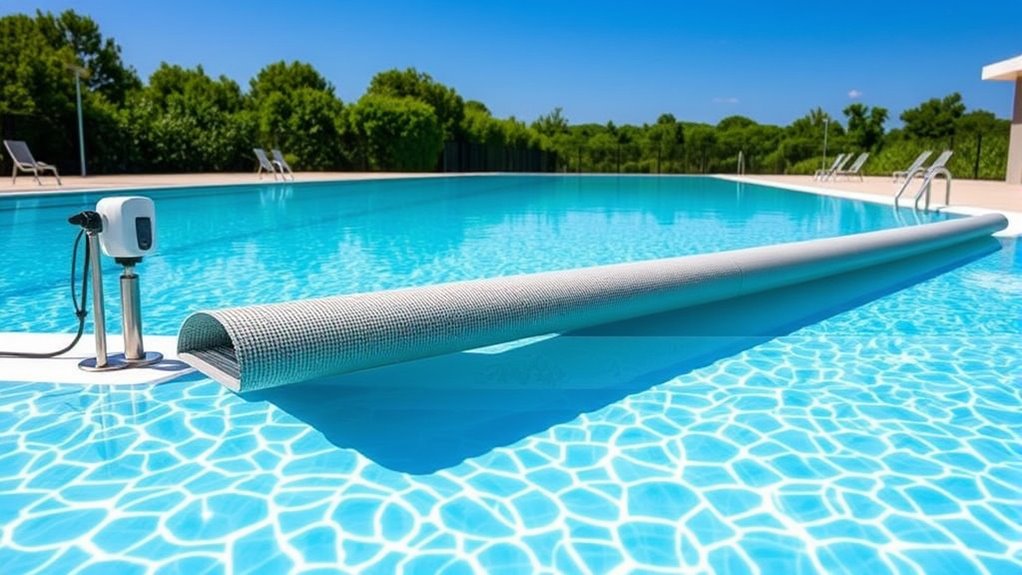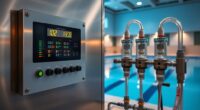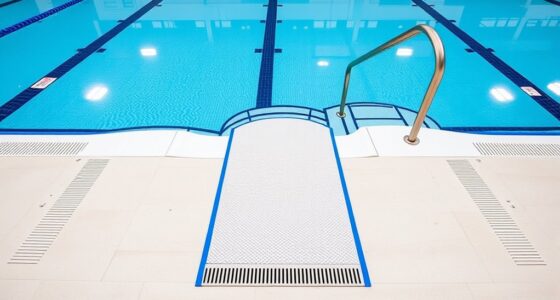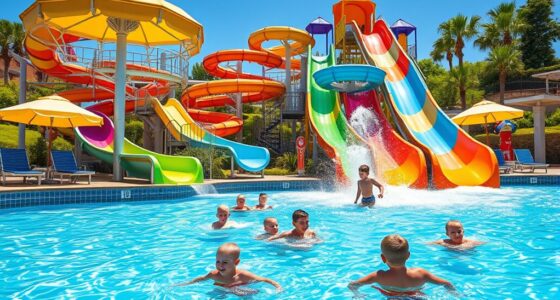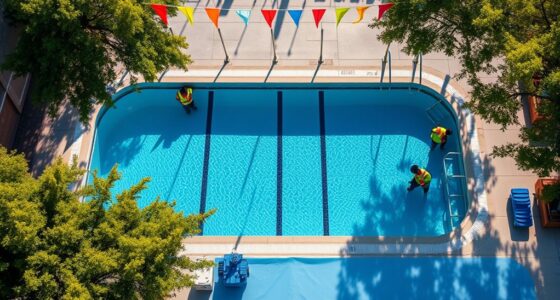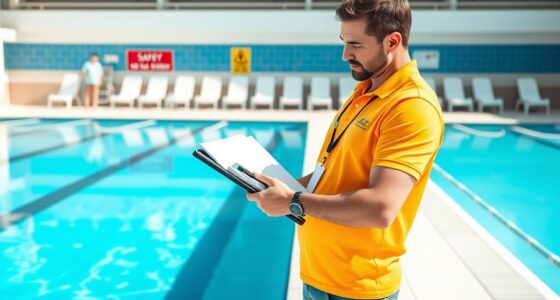To control evaporation in large pool facilities, consider using solar covers during off-hours to create a physical barrier that reduces water loss. Combining this with chemical additives helps stabilize surface tension, especially in hot or windy conditions. Proper installation and regular maintenance ensure maximum efficiency and longevity of your covers and treatments. Implementing both strategies can markedly cut water and chemical costs. Keep exploring for more effective tips to enhance your pool’s water conservation efforts.
Key Takeaways
- Implement floating solar covers to create a physical barrier, reducing water exposure to evaporation drivers.
- Use chemical evaporation retardants to form an invisible film, minimizing water loss without affecting water quality.
- Combine solar covers and chemical additives for comprehensive, cost-effective evaporation control in large pools.
- Ensure proper installation and maintenance of covers and additives to maximize durability and efficiency.
- Regularly monitor and adjust evaporation control measures based on weather conditions and pool usage.
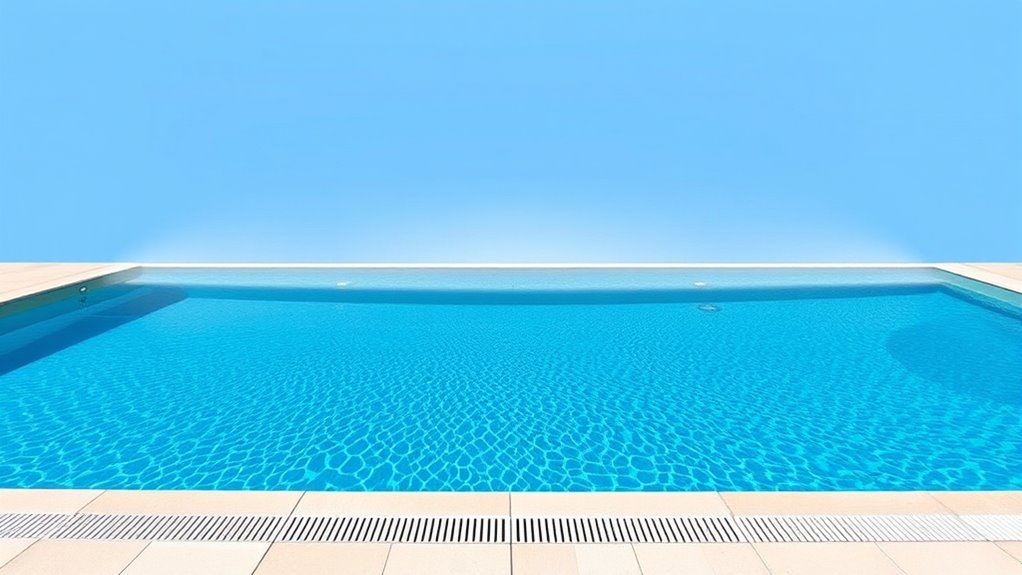
Are you struggling to reduce water loss due to evaporation? If so, you’re not alone. Evaporation can drain large amounts of water from your pool, leading to increased costs, more frequent refilling, and potential damage to the pool’s equipment. Luckily, there are effective solutions to help you manage this issue. One of the most straightforward methods is using solar covers. These covers, often made of lightweight, bubble-like material, sit directly on the pool’s surface. They act as a barrier, markedly reducing water exposure to air and sunlight, which are primary drivers of evaporation. When you cover your pool with a solar cover, you’ll notice a noticeable decrease in water loss, saving you both time and money in refilling and chemical treatment.
Using a solar cover significantly reduces water evaporation from your pool.
In addition to solar covers, chemical additives can also play an essential role in evaporation control. Certain chemical additives help stabilize the water’s surface, reducing the rate at which water escapes into the air. These products work by forming a thin, invisible film on the water’s surface that minimizes evaporation without affecting water quality or swimmer comfort. When used correctly, chemical additives can complement the physical barrier created by solar covers, providing an extra layer of protection against water loss. They’re especially useful during periods of high heat or windy conditions, where evaporation rates tend to spike.
Combining solar covers with chemical additives offers an all-encompassing approach to evaporation management. You can deploy the solar cover during the pool’s off-hours or when not in use, trapping moisture and conserving water. Meanwhile, chemical additives can be applied as part of your regular maintenance routine, ensuring the water’s surface remains less prone to evaporation even when the cover isn’t in place. This dual strategy is particularly effective for large pool facilities, where water loss can be substantial and costly over time. Proper installation and maintenance of solar covers are essential for maximizing their efficiency. Make sure the cover fits snugly without gaps, and remove it carefully to avoid tearing. When it’s time to refill, you’ll appreciate how much less water you need to add, thanks to the evaporation reduction. Using chemical additives judiciously, following manufacturer guidelines, will help sustain the surface tension, further curbing evaporation rates. Together, these solutions can dramatically improve water conservation, lower operational costs, and extend the lifespan of your pool’s equipment.
Additionally, understanding the effectiveness of different evaporation control methods can help you choose the most suitable solution for your specific large pool facility, ensuring optimal water savings and cost efficiency.
Frequently Asked Questions
What Are the Environmental Impacts of Evaporation Control Methods?
You might worry about the environmental impacts of evaporation control methods, but many are designed with environmental sustainability in mind. For example, using floating covers reduces water loss without creating chemical runoff, minimizing pollution. However, some chemical-based solutions could pose risks if they runoff into nearby ecosystems. It is crucial to choose eco-friendly options to protect water quality and ensure your pool’s operations remain environmentally responsible.
How Do Evaporation Control Solutions Affect Water Chemistry?
Evaporation control solutions help maintain your pool’s chemical balance by reducing water loss, which minimizes the need for frequent chemical additions. They prevent fluctuations in pH and chlorine levels, making it easier to keep water safe and clear. By conserving water, these solutions also support water conservation efforts. Overall, they stabilize water chemistry, improve pool longevity, and promote a healthier swimming environment for users.
Are There Cost-Effective Options for Small-Scale Facilities?
You’ll be amazed at how affordable small-scale solutions can drastically cut water loss! For cost-effective options, consider floating covers or solar blankets—they’re simple, budget-friendly, and highly effective. Using aerators or shade structures also helps reduce evaporation without breaking the bank. These small-scale solutions make a big difference, saving water and money, so you can keep your pool pristine without overspending.
How Long Do Evaporation Control Products Typically Last?
Evaporation control products usually last between one to three years, depending on pool cover efficiency and chemical compatibility. You should regularly inspect your cover for signs of wear or damage and replace it when its effectiveness diminishes. Proper maintenance and choosing products compatible with your pool’s chemicals help prolong their lifespan, ensuring continued evaporation reduction and better overall pool management.
Can Evaporation Control Solutions Be Combined With Other Pool Maintenance Strategies?
Yes, you can combine evaporation control solutions with other pool maintenance strategies. Just guarantee chemical compatibility by checking product labels and guidelines. Follow proper installation procedures to avoid issues and maximize effectiveness. For example, integrate evaporation control products with regular water balancing, filtration, and chemical treatments. This combined approach helps maintain ideal water levels, reduces evaporation, and keeps your pool in great condition without compromising any component’s performance.
Conclusion
By implementing these evaporation control solutions, you’ll protect your large pool facility like a sturdy shield against water loss. Think of it as giving your pool a gentle raincoat on a dry day—preserving your water levels and saving costs. Don’t let evaporation chip away at your resources; take action now. With these strategies in place, your pool will stay full and inviting, ready to make a splash whenever you are.
